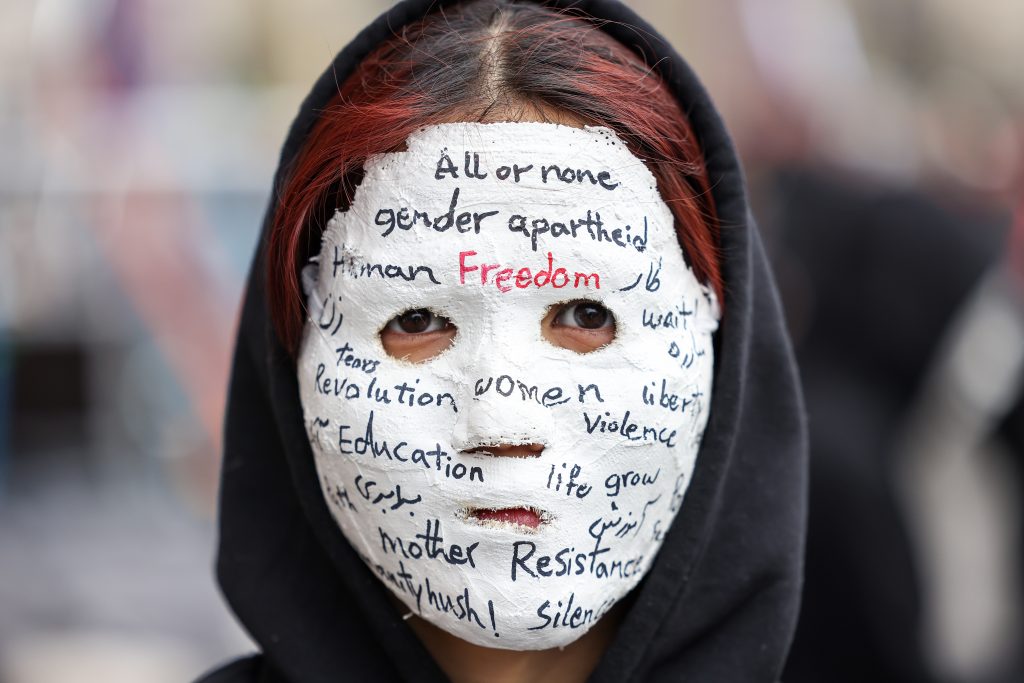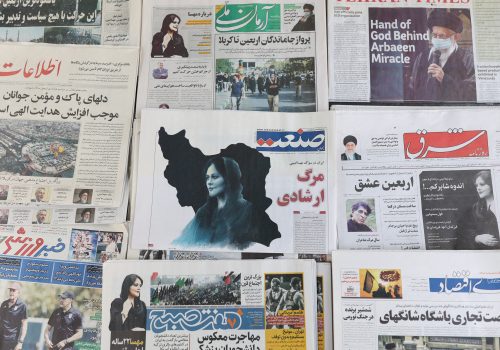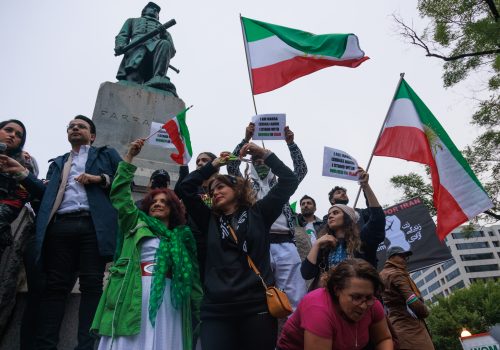Next week, the United Nations legal committee (the UN Sixth Committee) will meet to debate its draft treaty on crimes against humanity. When it does so, it must include one of the most brutal and society-stunting crimes in the world today: the crime of gender apartheid.
On October 5, the Atlantic Council’s Strategic Litigation Project, together with the Global Justice Center, issued a joint letter and legal brief urging the international community to codify the crime of gender apartheid in the UN’s crimes against humanity treaty. The letter and legal brief were endorsed by dozens of prominent jurists, scholars, and civil society representatives. This includes Afghan women’s rights defender Shaharzad Akbar and Nobel laureates Shirin Ebadi, Malala Yousafzai, and Nadia Murad. It also includes South African jurists Justice Richard Goldstone and Navi Pillay, former US Secretary of State Hillary Clinton, former Irish President Mary Robinson, former International Criminal Court Chief Prosecutor Fatou Bensouda, and renowned global feminist Gloria Steinem. Former Executive Director of Human Rights Watch Kenneth Roth, former Mongolian President Tsakhiagiin Elbegdorj, and Baroness Helena Kennedy endorsed the letter and legal brief as well.
The prominence and diversity of this group speak to the high stakes of this issue. Some people might be encountering this term for the first time, however, so it is worth exploring the crime of gender apartheid in greater detail.
1. What is gender apartheid?
Gender apartheid occurs when perpetrators seek to maintain a form of governance designed to systematically oppress and dominate another gender group or groups so that the dominant group may live alongside them and benefit from their subjugation.
In Afghanistan, gender apartheid is seen in the Taliban banning women and girls from education and almost all employment, and from traveling long distances without a male guardian, all while having to abide by a severe dress code. Women in Afghanistan are banned from almost all public spaces including public parks, gyms, and most recently beauty salons.
In Iran, gender apartheid is seen in the Islamic Republic not allowing a woman the right to divorce her husband or to gain custody of her children, and in banning women from obtaining a passport and traveling outside the country without the permission of a male guardian. Women in Iran are banned from many fields of study and are not permitted into sports stadiums. Their lives and their testimony are worth half a man’s under the law, and they are forced to wear compulsory hijab.
Gender apartheid in these countries is seen in a series of policies and daily abuses that bar women and girls from engaging in public life and having hopes of any financial autonomy. It is in all these measures designed and enacted by the Taliban and the Islamic Republic as a system of governance that aims to compress and relegate Afghan and Iranian women and girls into narrow roles: as child-bearers, child-rearers, and sources of unremunerated domestic labor.
Although it has not yet been codified as a crime under international law, gender apartheid has long been recognized as a concept. It dates back at least to the Taliban’s first takeover of Afghanistan in 1996. In our letter to UN member states, we’ve defined the crime of gender apartheid as the commission of inhuman acts with the intent to maintain an institutionalized regime of systematic oppression and domination of one gender group over another. This amends the existing definition of the crime of race-based apartheid under the Rome Statute—the animating document of the International Criminal Court—to encompass the same act and mental element, but with regard to domination of gender groups rather than racial groups.
2. Why should gender apartheid be recognized under international law?
The addition of the crime of gender apartheid under international law will give victims and survivors a clear legal avenue to hold perpetrators—whether state or individual—to account for the totality of crimes being perpetrated against them. The situations of women and girls living under the Taliban and Islamic Republic of Iran, for example, demonstrate just what’s at stake. As these regimes continue to tighten their grip, aiming to entrench a system of governance that eviscerates any semblance of women and girls’ autonomy and agency, every available option is needed to prevent and punish the full scale of their conduct. Codifying gender apartheid would equip the international community with a new and powerful tool for accountability to mobilize against these deteriorating situations.
3. Who supports the codification of gender apartheid?
On March 8, 2023 a group of prominent Afghan and Iranian human rights defenders, international jurists, and civil society leaders launched the End Gender Apartheid Campaign, which calls for the global recognition of the crime of gender apartheid. Their demands were powered by the deteriorating situation for women and girls in Afghanistan with each successive Taliban decree and the rise of the “Woman, Life, Freedom” movement in Iran capturing global attention in support of women’s rights in these countries.
The campaign builds upon a long history of work on this issue. For decades, international officials, lawyers, scholars, and activists have increasingly recognized the commission of gender apartheid and sought to codify it. Over the last year, UN Secretary-General António Guterres and other UN experts specifically recognized the deteriorating situation for women and girls in Afghanistan as gender apartheid. UN experts have also come together to caution against laws in Iran that are a form of gender apartheid. Just last month, UN Women’s Executive Director Sima Bahous called on the international community to explicitly codify gender apartheid under international law.
4. What can the international community do to recognize gender apartheid?
The United Nations has a unique opportunity to codify gender apartheid as a crime under international criminal law because the draft crimes against humanity treaty—the first major global treaty on core international crimes since the 1998 Rome Statute of the International Criminal Court—is moving forward. However, the International Law Commission’s draft articles, the starting point for the treaty, replicate the twenty-five-year-old definition of apartheid from the Rome Statute, which focuses on race-based apartheid only. The Rome Statute’s focus is not surprising given the recent memories of apartheid-era South Africa when it was written, but the definition of apartheid can and should be expanded today.
The letter we issued to UN member states—endorsed by dozens of leading jurists and rights defenders, including those who worked to dismantle the apartheid regime in South Africa—urges states to amend the draft definition of the crime of apartheid to encompass gender-based apartheid, too. UN member states will have an opportunity to debate next steps for the draft treaty on October 11-12 during the ongoing UN Sixth Committee session. They can then submit written comments by the end of this year and debate the draft treaty provisions in substance in April 2024.
5. How is gender apartheid distinct from the international crime of gender persecution?
The crime of apartheid is different from what is on the books now because of its distinguishing intent and animating context. This means gender apartheid requires the commission of an inhuman act of requisite character with the intent to maintain an institutionalized regime of systematic oppression and domination. The crime of gender persecution requires neither such context nor intent. Rather, it concerns itself with the “severe deprivation of fundamental rights” where the victim or victims have been targeted “by reason of the identity of a group or collectivity or targeted the group or collectivity as such.”
The intent to maintain an institutionalized regime of systematic oppression and domination of one group over others is markedly different in scope and dystopian ambition from the crime of persecution, as serious and significant as the latter is. This is already recognized, without controversy, given that the current definition of race-based apartheid sits neatly alongside the crime of persecution on the ground of race in the Rome Statute’s 1998 codification of international crimes. To the extent that the two crimes involve overlapping facts, it is also well-settled under international law that courts can charge perpetrators with cumulative crimes in order to capture the full extent of criminal conduct.
6. How would prosecution work?
Accountability against governmental actors in Afghanistan and Iran has been tough. The proposed codification would open new avenues to hold perpetrators—both state and individual—to account.
If the crimes against humanity treaty is adopted and the crime of gender apartheid is included, countries that are party to the treaty would be obligated to criminalize gender apartheid and take other measures to prevent and punish crimes against humanity under their domestic laws. This could potentially open the pathway to prosecutions under the principle of universal jurisdiction, which essentially means that some crimes are so heinous that they can be prosecuted in courts anywhere, even if the perpetrator is from a different country, the victims are from a different country, or the acts occurred in a different country.
Iranian officials responsible for the architecture of gender apartheid do travel outside of Iran and into countries with universal jurisdiction laws—so this could expand options for prosecution of officials, much in the same way a former Iranian official was convicted by a Swedish district court in July 2022 for the executions of thousands of political prisoners in Iran’s jails. With respect to the Taliban, similar approaches may apply.
Codification of the crime of gender apartheid in the crimes against humanity treaty would also affirm the obligations of states and international organizations to prevent and punish gender apartheid, even if they’re not direct parties to the treaty. In this way, the hope is that codification will mobilize diplomatic, legal, and social movements of resistance, including in the contexts of Afghanistan and Iran, and also in similar crisis situations now and in the future.
Gissou Nia is the founder and director of the Strategic Litigation Project at the Atlantic Council and advisor to the End Gender Apartheid Campaign.
Further reading
Wed, Sep 13, 2023
Twenty questions (and expert answers) about Iran one year after Mahsa Amini’s death
New Atlanticist By
A year after the twenty-two-year-old Kurdish-Iranian woman died following her arrest by authorities, Iran has changed—and is still changing—in important ways.
Thu, Sep 21, 2023
The House passed the MAHSA Act. Now what?
IranSource By Celeste Kmiotek, Lisandra Novo, Gissou Nia
The MAHSA Act—which focuses on targeted sanctions—will have to be approved by the Senate and signed by the president to become law.
Mon, Oct 2, 2023
Strategic Litigation Quarterly Newsletter: Exploring new and existing paths toward accountability
Strategic Litigation By
SLP has continued to work on an archive documenting open-source evidence of human rights violations in Iran and on engaging with UN member states ahead of the body's review of China.
Image: A masked woman takes part in a demonstration by Afghan women's and diaspora groups against the Taliban in Afghanistan. The demonstrators demand more rights and self-determination for women in their country.



